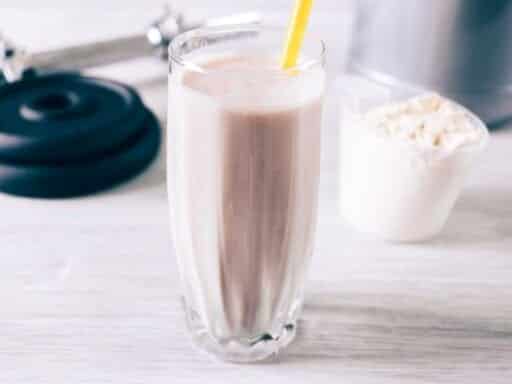Huel — a competitor to Soylent — is my breakfast and lunch. This is what I get out of it.
When Soylent debuted in 2014, it quickly became associated with the tech community — first because it received both backing and support from startup incubator Y Combinator, second because of a crowdfunding campaign that earned over $1 million, and third because of its basic concept: By adding water to a nutritionally optimized powder, you could successfully hack food.
Today, Soylent’s website no longer focuses on the product’s glycosidic bonds; instead, it reminds us that “you feel good when you fuel good” and that Soylent is “better for the planet.” Huel, one of the major competitors in the sustainable nutrition space, calls itself “nutritionally complete, convenient, affordable food with minimal impact on animals and the environment.” These products aren’t just for people who want an efficient way of consuming nutrients; they’re also being marketed as an ethical, environmentally friendly, and affordable way of feeding ourselves.
It seems this was always the plan. “The founders [of Soylent] wanted to create a product that would not only simplify nutrition in a meal that was simple to make and simple to consume, but they also wanted to create a product that would solve for food insecurity as populations grew and resources became more scarce,” Julie Daoust, senior vice president of product development and innovation at Soylent, told me. Since their respective launches, both Huel and Soylent have expanded their reach — you can find ready-to-drink Soylent in Walmart and at gas stations — and they’ve picked up a growing community of users. A quick survey of Huel’s and Soylent’s Reddit and Instagram communities reveals that these products are being consumed by office workers, retail workers, people in the military, people on offshore oil platforms, bodybuilders, hikers, college students, medical students, and more.
And then there’s me.
I first learned about Huel in 2017 after researching and testing a variety of meal replacement shakes for Reviews.com. While many of the products I taste-tested were both delicious and nutritious, there was something different about Huel. It tasted like food, not like something you consumed instead of food. I signed up for my own monthly Huel subscription as soon as I turned in my draft.
Currently, I pay $139.50 every five weeks for five bags of Huel (three chocolate flavor, two vanilla flavor) that I can then turn into shakes. Each bag includes 1,700 grams of Huel; 100 grams provides at least 20 percent of your recommended daily allowance of all necessary vitamins and minerals plus 58 percent of your recommended protein intake, 15 percent of your carbs, 16 percent of your fat, and 32 percent of your fiber, and clocks in at 400 calories. In the evenings, I fill two Huel-branded shakers with 150 grams of Huel and 500 ml of water; after chilling in the fridge and thickening overnight, I have two 600-calorie Huel meals ready to be eaten. Each meal, if I’ve done the math correctly, costs $2.49.
I do eat my Huel, by the way; I don’t drink it. I make my shakes with a little less water than Huel recommends so that my Huel is the consistency of melted ice cream. Then I pour my Huel into a bowl and eat it with a spoon. When I’m not rushed, a bowl of Huel takes me about 20 minutes to finish, which makes me feel like I’ve had a real meal.
Because Huel is a real meal. As Huel’s website, in a section helpfully titled Huel is Food, reminds us, “Humans have been turning foods into flour — a powder — for over 30,000 years; it’s not a new phenomenon. Huel is typically consumed in a liquid format and, while this may seem strange for a meal, soup is also a liquid!” Or, as I’ve often put it: A bag of Huel is no different than a box of cereal.
However, some dieticians and nutritionists argue that even the most optimized food products leave something out. As Luis Gonzalez, a registered dietician, explained: “Science has not yet been able to replicate what nature provides when it comes to nutrition.” If you want to eat a nutritious, environmentally friendly diet, Gonzalez suggests focusing less on meal replacements and more on whole fruits and vegetables from local farmers, in addition to occasional animal products from farms where those animals were “raised with sustainable practices.”
Jamie Sullivan, Soylent’s director of sustainability and corporate affairs, disagrees with this advice. “Telling people to eat more fruits and vegetables often tends to be 1 percent or a high-income solution, because the rest of us who are living at moderate or low incomes just don’t have the resources for that.” Not to mention that many of us don’t live anywhere near a local farmer. “Our No. 1 market in retail sales is New York City,” Sullivan said, “and it’s because lower- and moderate-income people get their food from bodegas.” Soylent is gaining popularity among the “younger working force,” as Sullivan put it, as well as college students across the country, many of whom buy it in bulk on Amazon.
The shipping issue might be a sticking point for some environmentalists, particularly those invested in the locavore movement. Same for those disposable ready-to-drink bottles, which Huel and Soylent both offer in addition to their powdered “just add water” products. However, as Huel co-founder and head of nutrition James Collier reminded me, the majority of our food comes in boxes and bottles and cans and trucks. “Compared to the environmental impact of everything, [transportation] is a minute thing,” Collier explains. “More important is getting people away from animal products, particularly cattle.”
Plenty of research indicates that if more of us were to adopt vegetarian or vegan diets — or to go meatless for the majority of our meals — it would be a net positive for the environment. As Andy Murdock explained in a 2017 Vox article about using diet to fight climate change: “Eating an average-sized steak for dinner has a comparable carbon footprint to driving about three miles in a standard gas-powered car. Get a large steak with some sides, and you easily double the impact.” This past April, Vox asked 15 experts what they thought would be “unthinkable” 50 years from now, and Dr. Melanie Joy (of Beyond Carnism) said “eating meat.”
Which means these sustainable meal products work to provide a complete nutritional package without any animal products or byproducts. Huel uses a high-protein pea and rice powder in combination with oats and flax. Soylent, as the name suggests, uses soy. According to Daoust’s recent lifecycle analysis, soy protein is the most sustainable nutritionally complete protein and contributes 25 percent less CO2 emissions than pea/rice protein; according to Collier, pea/rice protein is the better nutritional choice and is worth the slightly higher environmental cost.
The nutritional differences between the two products might be why Daoust said, “Soylent can replace any meal but it’s not really designed to replace all meals,” and why Collier said, “While we don’t actively recommend that people consume 100 percent Huel powder, I would be perfectly relaxed and happy if someone did.” He suggests eating two Huel meals and one non-Huel meal per day, which is exactly what I’ve been doing since September 2017.
It’s also the method that many other Hueligans (yes, that’s what we’re called) have adopted: Huel for breakfast and lunch and a non-Huel dinner. This allows us to share evening meals with family and friends while enjoying all the advantages of consuming Huel — the nutrition, the minimal prep and cleanup, the environmental benefits — as the bulk of our diet.
However, some of these Hueligans are concerned that a one-size-fits-all food solution might not actually be appropriate for all bodies. When you visit the Huel Forums, for example, you find multiple threads asking whether Huel is designed primarily for men. In a world where customized vitamin subscription startups are arguing that each of us requires a unique recommended daily allowance of vitamins and minerals — or, at least, that women’s nutritional needs differ significantly from men’s — how can one food product claim to provide balanced nutrition for everybody?
I brought this concern up with Collier, who clarified that “Huel is designed for every adult,” and that in the cases where women were shown to need more of a certain nutrient than men, such as iron, they optimized Huel to meet a woman’s needs. I also asked whether Huel was designed for every body size, and Collier explained that adult users of different sizes who consumed Huel in proportion to their caloric needs would receive appropriate nutrition.
This, however, brings us to the next major user concern: that Huel might have too many vitamins and minerals per serving, particularly if you enjoy Huel so much that you drink more than you “need.” So many people have asked about Huel’s high manganese level, for example, that Huel now has a dedicated statement addressing manganese toxicity which clarifies that there has “never been a reported case of anyone consuming too much manganese from food.”
I didn’t even know I was supposed to worry about manganese until I started reading the Huel forums — but this type of nutritional nit-picking seems like a natural consequence of Huel users being deliberate about what they consume. When you quantify something, people start asking if your numbers are right; when a person is presented with a food item (say, a home-cooked meal, a restaurant hamburger) that doesn’t come with an attendant nutritional profile, they just, like, eat it.
That said, I signed up for my Huel subscription because I wanted the quantification. More specifically, I wanted something nutritious and easy to prepare that I could eat every day and feel the same way after I ate it. I didn’t want to have to continually organize a pile of perishable breakfast and lunch components into meals that left me satisfied (not hungry, gassy, or bloated), with the right balance of proteins, carbs, and fats to keep me focused for the rest of the workday. In short, I got into Huel because I didn’t want to have to think about food — or, to reverse Soylent’s slogan, to fuel good so I could feel good.
Which, okay, I can hear you grumbling about late capitalism and the idea that food shouldn’t be just fuel. I agree. There are times when food can and should be used as a sensory pleasure, as a method of caring for and connecting with others, and as an opportunity to share in new experiences. I’d also argue that there are times when food should simply be the best product — for your health, for your wallet, and for the environment — to help you meet the challenges of your day.
Whether nutrient shakes are the food of the future, however, is up for debate. Julie Heseman, a principal at food service industry consulting firm Foodservice IP, thinks this type of product won’t take off for one reason: it’s just not tasty enough. “While products like Huel and Soylent are nutrient-rich, they do not offer the craveability that is critical in widespread consumer acceptance and use.” Heseman believes that we’ll see more lab-engineered food products — whether plant-based protein like the Impossible Burger or lab-grown meat like Memphis Meats — which may be just as manufactured as Huel or Soylent but have the advantage of looking and tasting like a familiar meal.
Of course, plenty of Huel users are already transforming the Huel powder into more familiar foods. I’ve made Huel pancakes and Huel microwave mug cakes; if you want to get really fancy, Huel offers recipes for everything from butternut squash pizza (which features a dough made of unflavored/unsweetened Huel and wheat flour) to chocolate birthday cake. Both Huel and Soylent have recently expanded into the snack bar market as well, giving consumers a sustainable nutrition product that they can chew. These products don’t have to be shakes; they can also look like taquitos, Thai green curry soup, popsicles, and even s’mores.
As Sullivan put it: “We’re not asking people to give up their beautiful family meals.” We can still enjoy home-cooked dinners with our loved ones, still carry on the food traditions of our families and cultures, still visit restaurants. I’d like to believe that we can also begin incorporating sustainable food products that, to borrow Soylent’s phrasing, solve for affordable nutrition — whether that’s Soylent, Huel, Impossible Burgers, or whatever comes next.
I’ve been doing it for two years, after all. And it’s almost time for lunch.
Sign up for The Goods’ newsletter. Twice a week, we’ll send you the best Goods stories exploring what we buy, why we buy it, and why it matters.
Author: Nicole Dieker
Read More



